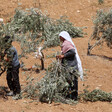Rights and Accountability 20 February 2025

Israeli soldiers forcibly displace Palestinians along a dirt road through Nur Shams refugee camp during the Israeli “Iron Wall” assault in the occupied West Bank, on 10 February 2025.
ActiveStillsIsrael is currently conducting the largest forcible displacement campaign of Palestinians in the occupied West Bank since 1967.
That was the year Israel occupied the West Bank, the Gaza Strip, Egypt’s Sinai Peninsula and Syria’s Golan Heights, and displaced hundreds of thousands of Palestinians from their homes in the process.
Nearly 40,000 Palestinians have been forced to flee their homes in refugee camps in the West Bank since Israel launched a massive assault focused on the Jenin refugee camp, Tulkarm refugee camp and Nur Shams refugee camp near Tulkarm, as well as Tubas, in the northern area of the occupied West Bank.
Those refugee camps have housed Palestinians forcibly displaced from their towns and villages in historic Palestine in the aftermath of the ethnic cleansing campaign by Zionist militias and the Israeli army that forcibly expelled hundreds of thousands of Palestinians in 1948.
United Nations human rights agency OHCHR said these were “levels of mass displacement unprecedented in the occupied West Bank for decades.”
While Israel has insisted its military assault is to crush armed resistance in the camps, Palestinians fear that the displacement is the goal.
Testimonies gathered by the human rights office include accounts from residents who were told by Israeli forces that they would not be allowed to return to the refugee camp.
Some residents reported being told by Israeli forces to “forget” the refugee camp.
The agency even reported receiving photos from Jenin refugee camp showing “freshly bulldozed roads with new signs apparently giving several streets Hebrew names.”
This must be understood in a broader context, alongside statements and actions by Israeli government officials signaling a push toward annexing the occupied West Bank.
“In this regard, we reiterate that any forcible transfer in or deportation of people from occupied territory is strictly prohibited and amounts to a crime under international law,” the human rights agency said.
Displaced Palestinians are reportedly sheltering with family or friends and in schools, mosques, wedding ceremony halls and other places.
While a small fraction – 3,000 out of 40,000 – has returned home, most remain displaced for more than three weeks. This displacement surpasses that of an Israeli assault during the second intifada in 2002, according to The New York Times, citing four unnamed experts.
Destruction
Even if Palestinians are allowed to return to their homes, they will find extensive destruction caused by Israel in their communities and refugee camps.
The damage was already significant before what Israel dubs the “Iron Wall” operation started on 21 January.
Between October 2023 and October 2024, there has been $16 million in damage and destruction in the housing sector in the occupied West Bank, according to a joint assessment report by the United Nations, the European Union and the World Bank Group.
Only 61 percent of health facilities in the assessed governorates were fully functional.
Water and sanitation systems have been destroyed in four refugee camps, according to the UN monitoring group OCHA, with some water infrastructure even contaminated by sewage.
Roads and vital infrastructure, including electricity, water and sewage systems, had already been severely damaged due to successive and prolonged Israeli raids on the refugee camps after 7 October 2023.
Israeli bulldozers have torn up stretches of roads under the pretext of uprooting improvised explosive devices planted by armed fighters to target Israeli military vehicles. While this method has inflicted punishment on camp residents uninvolved in the fighting, analysts have noted that it may not be effective in preventing the planting of these devices and could even make it easier for fighters to do so.
Jenin refugee camp – now standing nearly empty of its residents – is still being destroyed by Israel. Mayor Mohammed Jarrar told media that Israel “adopted a pattern of random destruction” to make the camp “uninhabitable.”
Settlement expansion
Meanwhile, amid this campaign of mass displacement, Israel’s settlement expansion is accelerating. Israel’s Civil Administration – the bureaucratic arm of Israel’s military occupation – published a new proposal to build nearly 1,000 new housing units in the Efrat settlement, near the Palestinian city of Bethlehem.
This would increase the Jewish-only population of the colony by 40 percent, according to Peace Now, a settlement watchdog group based in Israel.
This settlement is located in a highly strategic area of the occupied West Bank. If Israel annexes the settlement, it will sever the entire southern West Bank from the north, disrupting access to Highway 60, which runs west of the settlement and Palestinians depend on.
“For this reason, in all negotiations conducted to date between Israel and the Palestinians on a permanent settlement,” Peace Now said, “the Palestinians have insisted that Efrat not be annexed to Israel in order to ensure the territorial continuity of the West Bank and the development potential of the Bethlehem metropolis.”
The expansion area spans nearly 160 acres.
“While the people of Israel set their sights on the release of the hostages and an end to the war, the Netanyahu government is operating ‘on steroids’ to establish facts on the ground that will destroy the chance for peace and compromise,” Peace Now said.
Killings
During the operation, which is approaching its one-month mark, Israel has killed at least 44 Palestinians, including children, and injured many others, according to the UN human rights office. The Palestinian Center for Human Rights had estimated the number of those killed to be higher.
The military assault, a coordinated effort involving Israel’s military, domestic spy agency Shin Bet and Israel’s Border Police, includes the deployment of Israeli snipers in residential neighborhoods, home raids, the arrest of youth, aerial bombardments and the destruction of buildings and critical infrastructure, such as water, electricity and sewage systems.
On 12 February, Israeli forces killed a Palestinian child in the Nur Shams refugee camp and then confiscated his body.
Muhammad Ghassan Abed, 16, was in the Schools Area on the western side of the camp.
Defense for Children International - Palestine could not conduct a full field investigation as Muhammad’s body was confiscated, leaving the method of his killing unknown, as is the nature of his injury.
Two days after his killing, the Palestinian Authority’s health ministry received a report indicating that Israeli forces had confiscated three bodies from the Nur Shams refugee camp, including Muhammad’s. This information came through the Palestinian liaison coordinating with Israeli authorities.
Local media circulated a picture from the area showing an Israeli military bulldozer carrying rubble in its blade covered with a blanket. This raised suspicions that the bulldozer’s blade was transporting bodies, as this method has been used by Israeli forces in the past. His family had not received official notification of their child’s killing.
The mass forcible displacement of Nur Shams refugee camp’s residents is one reason there were no eyewitnesses who could have verified how Muhammad was killed.
“Israeli forces’ desecration of Muhammad’s body is a violation of international humanitarian law and international human rights law,” DCIP said.
A 15-year-old Palestinian boy died on 17 February from wounds he sustained on 1 February when he was hit by shrapnel from an Israeli drone strike targeting a nearby vehicle.
Diyaa al-Din Ahmad Sabaaneh was standing in front of his father’s shop in the Qabatiya neighborhood, south of Jenin, when the drone struck a car carrying two men. Shrapnel hit Diyaa al-Din in the head, DCIP reported.
He remained in a coma, and doctors were unable to operate due to the severity of his injuries.
Sabaaneh’s death brings to 14 the number of Palestinian children killed by Israel in the occupied West Bank since the beginning of the year, more than half of whom were killed by drone strikes, while most others were killed by live ammunition.
Meanwhile, commanders in Israel’s military appear to be loosening open-fire orders in the occupied West Bank.
“This is not what a ceasefire looks like,” Israeli human rights group B’Tselem said.
“Israel has transplanted the military practices it employed in Gaza to the West Bank.”





Comments
trail of tears
Permalink handala replied on
Ethnic cleansing is a crime against humanity because it is INHUMANE!!!
We don't have to exist in 'Universe25', it is still possible to grow the hell up and become what we are supposed to be: Grown ups who care about each other as human beings!
Add new comment